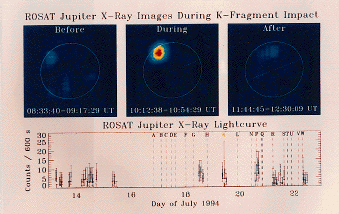

NOTE: Click on the image to view it at its highest resolution.
ROSAT images of Jovian X-ray emissions at the time of the K-fragment impact and overall lightcurve
The top three images show x-ray emissions from Jupiter as observed by the ROSAT High Resolution Imager (HRI) before, during, and after the impact of fragment K of Comet Shoemaker-Levy 9 on July 19. The middle panel shows intense x-ray emissions detected immediately following the impact. These emissions appear to originate from a region in Jupiter's midlatitude northern hemisphere that is connected by magnetic field lines to the impact site in the southern hemisphere. We believe the emissions result from the impact of energetic electrons that were either a) accelerated along the magnetic field lines from the impact site to the conjugate region or b) precipitated by impact-induced pitch- angle scattering from Jupiter's trapped radiation belts similar to the Earth's Van Allenbelts, although much larger and filled with more energetic particles). The collision of these highly energetic electrons with the gases in Jupiter's upper atmosphere produces x-rays through a mechanism known as bremsstrahlung. The x-ray emissions appear to be very well correlated with ultraviolet emissions from the same region observed by the Hubble Space Telescope near the time of the K fragment impact.
The lower plot shows that x-ray brightness of Jupiter before and during the impacts of the Shoemaker-Levy 9 fragments. While the K-fragment impact is the most obvious feature in the lightcurve, there are also hints of similar emissions following the P2 and W impacts.
The ROSAT satellite and x-ray telescope were built in Germany and are operated under the scientific leadership of the Max Planck Institute for extraterrestrische Physik. ROSAT was launched by NASA in 1990. The HRI was provided by the Harvard-Smithsonian Center for Astrophysics. The U.S. ROSAT Guest Observer Program is manager by NASA's Goddard SPace Flight Center.
The members of the ROSAT Shoemaker-Levy 9 observing team are: J. H. Waite, Jr. (Principal Investigator), G. R. Gladstone, C. Na, S. A. Stern, K. Franke (all of Southwest Research Institute); F. Bagenal (University of Colorado); J. T. Clarke (University of Michigan); and A C. Fabin and W. N. Brandt (Cambridge University). The director of the ROSAT project is J. Trumper (Max Planck Institute for Extraterrestrial Physics); the U.S. project scientist is Rob Petre (NASA Goddard Space Flight Center).